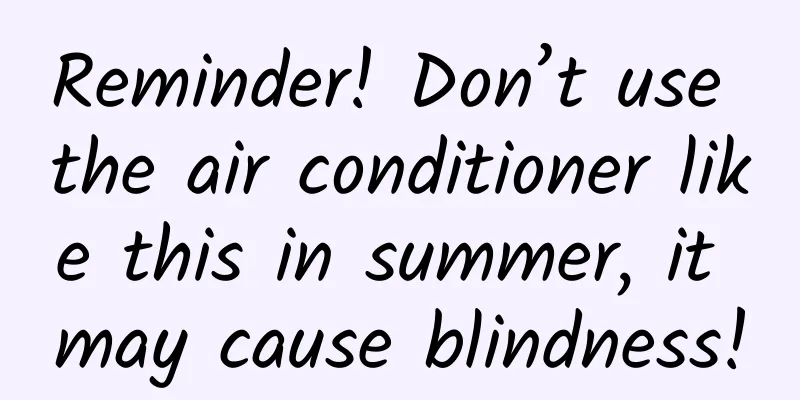Reminder! Don’t use the air conditioner like this in summer, it may cause blindness!

|
Expert of this article: Li Zongou, Master of Ophthalmology, First Affiliated Hospital of Dalian Medical University This article was reviewed by Lu Jianmin, chief physician, deputy director of the Department of Ophthalmology, the First Affiliated Hospital of Dalian Medical University Hot hot hot How many friends are like me? The first thing I do when I get home is turn on the air conditioner. That's right In summer, we need air conditioning to “extend our lives”! But many people don’t know that Continuously using low-temperature air conditioning can easily cause eye stroke! Weibo screenshot What exactly is an “eye stroke”? What are the symptoms? How do you determine whether you have this disease? Popular Science About Eye Stroke Let’s talk about it today What is an eye stroke? Eye stroke is medically known as retinal vascular occlusion. Because it is similar to cerebral stroke, some people call it "eye stroke". Copyright image, no permission to reprint Retinal vascular occlusion is caused by emboli, inflammation and other factors in the retinal blood vessels, which lead to occlusion: If the blocked blood vessel is an artery, it is called "retinal artery occlusion", which is an acute and severe eye disease that can cause irreversible damage to visual cells in a short period of time. If the blocked blood vessel is a vein, it is called "retinal vein occlusion", a common retinal vascular disease that can easily cause vision impairment or even blindness due to complications. Why does air conditioning cause eye stroke? The climate is hot in summer. If the indoor air-conditioning temperature is too low and the temperature difference between indoor and outdoor is large, when you suddenly enter a room full of cold air from outdoors, it is easy to cause abnormal contraction of blood vessels, which may not only cause cerebral stroke or myocardial infarction, but also cause eye stroke due to abnormal contraction of blood vessels in the fundus. There are many other factors that cause eye stroke, including: hypertension High blood pressure is closely linked to all strokes, whether they affect the blood vessels of the brain, heart or eyes. Copyright image, no permission to reprint Normal vascular endothelium is smooth and flat. Long-term high blood pressure can cause endothelial damage. Platelets, blood lipids and other substances in the blood will deposit at the site of vascular wall damage to form plaques. When these plaques are stable, they can cause vascular lumen stenosis and affect blood supply. Once the plaques rupture, the attached thrombus will fall off to the retinal blood vessels, which may cause retinal blood vessel obstruction and cause eye stroke. Dyslipidemia Hyperlipidemia can cause increased blood viscosity, abnormal blood rheology indicators, and lipid deposition in the vascular endothelium can easily lead to thrombosis. Smoking The harmful substances in cigarettes can cause vasoconstriction or vasospasm. Long-term and heavy smoking can even cause vascular embolism and lead to eye stroke. age As blood vessels in the elderly become less elastic and their walls gradually harden, advanced age is also a risk factor for eye stroke. However, in recent years, with the change in people's living habits and the accelerated pace of life, eye stroke has become younger and younger, and young people also need to pay attention. In addition, some patients may also experience ocular stroke due to high intraocular pressure, intraorbital hypertension, etc. during or after ophthalmic surgery. How to determine if you have an eye stroke? Different types of eye stroke have different degrees of harm and symptoms. According to the location of the blocked blood vessels, they can be divided into: (1) Retinal artery occlusion If the retinal artery is blocked, vision will drop significantly in a short period of time or even become completely blind due to retinal ischemia and hypoxia. It is usually a painless disease in one eye. Because the retina can tolerate ischemia for a short time, photoreceptors will die in a short time under hypoxia and cannot regenerate, resulting in permanent vision loss. Therefore, retinal artery occlusion must be treated immediately in an emergency to save vision. Copyright image, no permission to reprint Some patients may have experienced transient vision loss in the past and recovered on their own due to factors such as vascular spasm. If similar symptoms occur, you must be highly vigilant and go to the hospital in time to check your eye and cardiovascular and cerebrovascular conditions. (2) Retinal vein occlusion When the lesions are mild, there may be no obvious symptoms or only mild vision loss. Once the lesions accumulate to the macular area, secondary macular edema will occur, leading to symptoms such as a significant decrease in central vision, visual distortion, decreased contrast, and a central dark spot. If not treated promptly, new blood vessels may form in the anterior chamber angle and iris, causing increased intraocular pressure and extremely serious neovascular glaucoma, which can eventually lead to blindness. "Eye stroke" is very harmful to eye health. You can use the following methods to conduct preliminary self-tests: Self-diagnosis method for "eye stroke" 1. Amsler Grid Retinal vein occlusion can accumulate to the macula, leading to secondary macular edema. The Amsler grid chart, which is often used in ophthalmology, can be used for preliminary self-assessment of the condition of the macular area. How to use: Place the table about 30 cm above the horizon, cover your left eye, use your right eye to focus on the black dots in the table, and then test your left eye in the same way. If you observe that the squares are defective or deformed, be alert to the possible presence of macular degeneration. Amsler grid (photo provided by the author) 2. Visual field test Blockage of blood vessels in the retina may cause a reduction in visual field. Accurate visual field testing requires a perimeter test at a hospital, but you can roughly test your visual field at home with your hands. The visual field of both eyes is usually no less than 160 degrees. A visual field test can provide a simple understanding of your own visual field. It is worth noting that if you experience symptoms such as decreased vision, distorted vision, and a narrowed field of vision, do not blindly assume that you have suffered an eye stroke. Many diseases can also cause similar symptoms, such as optic nerve atrophy, retinitis pigmentosa, and extensive retinal choroidal lesions. You need to go to the hospital for further examination to clarify your eye condition. What else should we pay attention to when using our eyes in summer? Low air humidity, dry eyes should be paid attention to In the hot summer, people generally choose to stay in air-conditioned rooms. However, if the doors and windows of the room are closed for a long time, the indoor air cannot circulate, the humidity is reduced, and the eyes are easily dry and tired. Copyright image, no permission to reprint Usually, you should open windows for ventilation, avoid staying in air-conditioned rooms for long periods of time, and never let the air conditioner blow directly on your face. Swimming is refreshing, but infection should be prevented Summer is also a good time for swimming, but you need to protect your eyes before swimming. Try to choose a swimming pool with good water quality and good sanitary conditions. If the water in the swimming pool is polluted and there is no effective protection for the eyes, it is very likely to cause acute conjunctivitis due to bacterial or viral infection. If you experience severe conjunctival congestion and edema, increased eye secretions, etc. after swimming, rinse with clean water immediately and seek medical attention. The summer sun is good, protection is essential There is plenty of sunshine in the summer. In addition to protecting your skin from the sun when you are outdoors, you also need to protect your eyes from the sun. Copyright image, no permission to reprint Sunlight contains short-wave blue light that is harmful to the human eye. Long-term exposure to short-wave blue light may cause damage to the macula of the fundus. Therefore, you can wear sunglasses outdoors and try to avoid looking directly into the sun. The watermarked images and cover images in this article are from the copyright gallery, and the image content is not authorized for reprinting |
<<: When people get old, do they really smell like old people?
>>: Where do the rocks in the universe come from? Are most planets made of rocks? Here's the truth
Recommend
How can we create explosive content? You must read this article!
Why is it that when we see content from self-medi...
Can a vegetarian be a muscular man?
Recently, I have been paying attention to the iss...
Aston Martin recalls 1,658 vehicles worldwide, Chinese dealers to take the blame
According to Reuters, Andy Palmer, CEO of British...
Mourinho's view on the hot money model focusing on leading stocks column video
Mourinho's market-watching hot money model fo...
8 Tik Tok promotion skills to teach you how to play Tik Tok from scratch!
In the mobile era, traffic entrances were Weibo a...
World Hate Cilantro Day丨Does cilantro smell good or bad to you?
Science Fiction Network, February 24 (Xu Mingyang...
National Industrial Information Security Development Research Center: Panorama of Socialized Digital Supply Chain in 2021
Recently, the National Industrial Information Sec...
Understand these 5 types of activity classification to make operations more efficient
Clarifying the purpose of an event should be the ...
3.15 Know More | Uncover the Truth Behind “Free WiFi”
The 3.15 Gala exposed that the "free WiFi&qu...
A collection of features of 17 mainstream online marketing and promotion channels!
We have sorted out 17 mainstream online marketing...
[Popular Science of Chinese Military Technology] The exoskeleton in the movie "The Wandering Earth" already exists in reality
"The Wandering Earth 2" once again made...
WeChat status can be set as QQ music. Netizens: Can you make it more practical?
July 15 news: Recently, the iOS version of WeChat...
“Soul” product operation analysis!
Social needs are the third need based on physiolo...
Practical Tips | Teach you how to write a product experience report that will make HR scream (taking Baidu Maps as an example)
During the job search process, a complete product...









